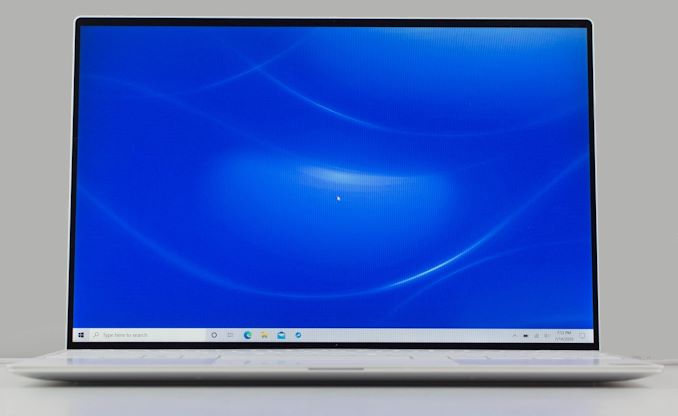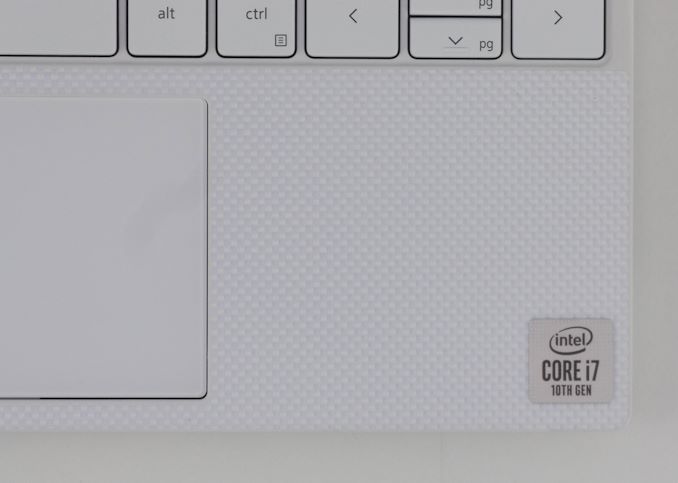The Dell XPS 13 (9300) Review: Return of the King
by Brett Howse on July 16, 2020 10:00 AM EST
Dell changed the Windows laptop market in a single stroke with the launch of the updated XPS 13 back in 2015, ushering in the world of the InfinityEdge display, and moving the entire industry forward. We were fortunate enough to get a chance to check out the precursor to the new XPS 13 back in November, with a review of the XPS 13 2-in-1. Dell had chosen not to rest on their laurels, and the 2-in-1 proved to be one of the best notebooks around if you needed a compact and powerful convertible laptop. Today we are evaluating the traditional clamshell version of the XPS 13, and while it offers many of the same features and design touches, it does so in a more familiar form factor that many customers are going to prefer.
For the 2020 refresh, Dell has made the refreshing move to taller displays, as we saw with the XPS 13 2-in-1. As a result the XPS 13 uses 13.4-inch display panel with a 16:10 aspect ratio, offering more vertical space for getting work done, and some convenient padding to place controls when watching 16:9 content. The larger display fits into a chassis that is actually 2% smaller than the outgoing design, with the new XPS 13 offering a 91.5% screen to body ratio.
This is actually the second time that Dell has refreshed the XPS 13 within the last year. The company previously updated the XPS 13 in August 2019 to use Intel's 10th generation Core processors, but presumably due to limited supply of Intel’s then-new Ice Lake platform, Dell opted to launch that iteration with Comet Lake-U processors. And under more normal circumstances we would have expected Dell to stick with an annual cadence – and thus Comet Lake – for an entire year. Instead, to some surprise, Dell gave the XPS 13 a further mid-generation refresh, launching the Ice Lake-based XPS 13 9300 model that we are reviewing today, and bringing the clamshell XPS 13 to parity with the 2-in-1 version.
The switch from Comet Lake to Ice Lake, in turn, is a significant one. it means the XPS 13 gets Intel’s new Sunny Cove CPU architecture, as well as the much-improved Gen 11 graphics. Dell offers Core i3, i5, and i7 models, with the Core i3 and i5 offering G1 graphics, meaning 32 Execution Units (EUs), and the top-tier Core i7-1065G7 featuring the full 64 EUs on the GPU side. Just as a comparison, the Comet Lake-U only offered 24 EUs of Gen 9.5 graphics, so even the base Ice Lake models still offer a 33% larger (and much newer) GPU than the outgoing models.
The move to Ice Lake also brings some badly-needed LPDDR4X support, which in turn means a 32 GB maximum memory option in the XPS 13 9300, up from 16 GB previously. Although Dell still lists a paltry 4 GB option on their specifications sheet, a quick look at the Dell.com site shows that, at least in the USA, it appears that 8 GB is the new minimum, and that is a welcome change. Offering just 4 GB of RAM in a premium Ultrabook was always a poor choice, even if it did allow Dell to hit a slightly lower price bracket. On the storage front there is more good news, with 256 GB the new minimum, with up to 2 TB available, and all drives are PCIe x4 NVMe offerings.
| Specifications of the Dell XPS 13 9300-Series | |||
| General Specifications As Tested: Core i7-1065G7 / 16GB / 512GB / 1920x1200 |
|||
| LCD | Diagonal | 13.4-inch | |
| Resolution | 1920×1200 | 3840×2400 | |
| Brightness | 500 cd/m² | 500 cd/m² | |
| Contrast Ratio | 1800:1 | 1500:1 | |
| Color Gamut | 100% sRGB | 100% sRGB 90% P3 |
|
| Features | Dolby Vision | Dolby Vision | |
| Touch Support | with or without touch | Yes | |
| Protective Glass | Corning Gorilla Glass 6 in case of touch-enabled model | ||
| CPU | Intel Core i3 1005G1 (4MB cache, up to 3.4GHz) Intel Quad Core i5 1035G1 (6MB cache, up to 3.6GHz) Intel Quad Core i7 1065G7 (8MB cache, up to 3.9GHz) |
||
| Graphics | Intel UHD Graphics Intel Iris Plus Graphics |
||
| RAM | 4 - 32 GB LPDDR4X-3733 DRAM (soldered/onboard) | ||
| Storage | 256 GB PCIe 3.0 x4 SSD 512 GB PCIe 3.0 x4 SSD 1 TB PCIe 3.0 x4 SSD 2 TB PCIe 3.0 x4 SSD |
||
| Wireless | Killer AX1650 Wi-Fi 6 + Bluetooth 5.0 (based on Intel's silicon) Killer AX500 Wi-Fi 6 + Bluetooth 5.0 (based on Qualcomm's silicon) |
||
| USB | 3.1 | 2 × TB 3/USB Gen 3.1 Gen 2 Type-C | |
| 3.0 | - | ||
| Thunderbolt | 2 × TB 3 (for data, charging, DP displays) | ||
| Cameras | Front | 720p HD webcam | |
| Other I/O | Microphone, 2 stereo speakers, audio jack | ||
| Battery | 52 Wh | 45 W AC Adapter (USB Type-C) | ||
| Dimensions | Width | 295.7 mm | 11.64 inches | |
| Depth | 198.7 mm | 7.82 inches | ||
| Thickness | 14.8 mm | 0.58 inches | ||
| Weight | non-touch 1.2 kilograms | 2.64 pounds touch-enabled 1.27 kilograms | 2.8 pounds |
||
| Launch Price | Starting at $999.99 | ||
Dell has gone all-in on USB-C with the new XPS 13, with one port on each side of the notebook. Both feature Thunderbolt 3 with 4 lanes, as well as power delivery for charging. The lack of a Type-A port may inconvenience some, but Dell does include an adapter in the box to assist. Wireless is the Killer AX1650, which based on the latest Intel AX200 wireless adapter – and with Intel purchasing Killer this partnership seems like it is not going anywhere.
If you read our review of the 2-in-1 version of this laptop, you will undoubtedly notice a lot of similarities. As they are from the same product line, that is not an accident: Dell has now refreshed their entire XPS series of laptops with a similar design philosophy. Let’s take a peek at what is new.











224 Comments
View All Comments
Korguz - Friday, July 17, 2020 - link
Santoval, look who made the comment, there is no need to say anything else. its self explainitory.Santoval - Friday, July 17, 2020 - link
Is it? I have no idea who "Deicidium" is, sorry..Korguz - Friday, July 17, 2020 - link
then you haven't been reading here that much. he will bash and any chance he can, while praising his gods intel and nvidia, with no proof at all of his claims.Korguz - Friday, July 17, 2020 - link
bash amd any chance he canDeicidium369 - Friday, July 17, 2020 - link
I got you mixed up with Spungy, have no clue who you are either.Deicidium369 - Friday, July 17, 2020 - link
Run along little boy.Deicidium369 - Friday, July 17, 2020 - link
Zen 1 vs Zen 3 are minor architectural tweaks and improved manufacturing and packaging ("chiplets" and IO die) - per core performance has not increased any more than Skylake to to Coffee Lake to Comet Lake. Minor tweaks. So still competing at Skylake level perormance.Well moved on - Last 14nm server CPU has shipped - last 14nm desktop CPU is shipping later this year. Ice Lake is widespread enough to count - in way more designs than AMD.
Leaks show that 8C monstrosity to be 17% better perf than 4 cores on Tiger Lake.
Rocket Lake is basically backported Ice Lake/Tiger Lake to 14nm - so no Skylake there. Sunny Cove/Willow Cove/Golden Cove ARE NOT SKYLAKE. New arch. I know you know this.
Korguz - Friday, July 17, 2020 - link
going by that same logic, all intel cpu's since skylake are also minor architectural tweaks and improved manufacturing as well, whats your point ?" Last 14nm server CPU has shipped - last 14nm desktop CPU is shipping later this year" oh ? lets see you post proof of this. oh wait, you cant, cause there isnt any proof.
" Leaks show that 8C monstrosity to be 17% better perf than 4 cores on Tiger Lake. " like another mentioned, still cherry picking are you ?
IF it was a new architecture, intel them selves would of called it gen 1, not gen 10/11/12/etc.
schujj07 - Saturday, July 18, 2020 - link
Per core performance hasn't increased from Zen 1 to Zen+, to Zen 2??? Whatever you are smoking I hope you share. Clock for clock Zen 2 is about 18% faster than Zen 1, that means per core performance is higher. Whereas Intel hasn't increased per core performance since 2015. Before that Intel hadn't had more than minor changes since the change from Nehlema to Sandy Bridge. After that they had nothing more that 5% IPC improvements, all other performance increase was sheer clock speed.Odds are that Rocket Lake will not clock as high as Skylake derivatives. It will need to have a massively higher IPC to counteract the loss of clock compared to Comet Lake. On top of that it will probably be very power hungry due to the bigger chip and added complexity.
gescom - Friday, July 17, 2020 - link
Similar single performance at much lower power consumption.https://www.notebookcheck.net/Lenovo-ThinkPad-T14s...